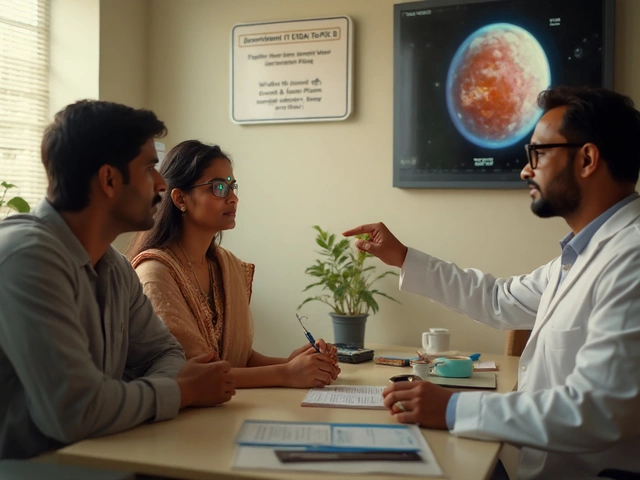Let's get straight to it. When it comes to cancer, it's no surprise everyone is looking for a silver lining amidst the storm. While not all cancers come with high survival odds, some do. Knowing which ones can offer a bit of relief—or even hope—since understanding is half the battle.
Let's start with the big one: prostate cancer. It's one of the most common—but also one of the most treatable. Thanks to routine screenings and advances in treatment, the survival rates are quite impressive. Catch it early—your chances skyrocket.
Another encouraging aspect is thyroid cancer. Often caught during routine exams, its treatment success is high. Most people diagnosed with thyroid cancer lead full, healthy lives post-treatment. I mean, who knew an incidental finding at your doctor's office could be life-saving, right?
Finally, there's testicular cancer, which primarily affects younger men. It's highly treatable, especially when diagnosed early. With consistent regular check-ups and awareness, the odds are strongly in your favor.
- Understanding Cancer Survival Rates
- Prostate Cancer: Leading in Survival
- Thyroid Cancer: A Positive Prognosis
- Testicular Cancer: High Success in Treatment
- Steps to Improve Survival Odds
Understanding Cancer Survival Rates
When we talk about cancer, the term 'survival rates' often gets thrown around. But what does it really mean? Simply put, a survival rate is a measure of how many people are still alive after a certain period post-diagnosis. This gives us a picture of how effectively different cancers can be treated.
Let's break it down a bit. Typically, survival rates are calculated over a five-year period. So, when you hear that a certain cancer has a five-year survival rate of 90%, it means that 90% of patients diagnosed with that cancer are still alive five years later. Now, here's an interesting tidbit: these statistics often come from large studies, so they might not precisely predict individual outcomes, but they offer a valuable overview.
Factors Influencing Survival Rates
Various factors impact these rates. Early detection is a crucial one. Cancers caught at an early stage tend to have better outcomes. Thanks to modern screenings, cancer treatment these days starts earlier than before, which is great news.
Another big factor is the cancer type. Interestingly, some cancers respond incredibly well to treatments. For instance, surgical interventions and radiation are quite effective in prostate cancer, leading to its high survival rates.
Moreover, breakthroughs in targeted therapies and immunotherapy have improved outcomes for many cancers. These advancements tailor treatments to the specific characteristics of a patient's cancer, resulting in higher survival rates.
Comparing Different Cancers
| Cancer Type | 5-Year Survival Rate |
|---|---|
| Prostate Cancer | ~98% |
| Thyroid Cancer | ~98% |
| Testicular Cancer | ~95% |
Looking at the table, you can see how survivable cancers like prostate and thyroid have high survival percentages. It's encouraging, isn't it? These numbers spotlight the effectiveness of contemporary treatment approaches.
Keep in Mind
Though stats are helpful, remember: every individual case is unique. Factors like overall health, lifestyle, and response to treatment vary widely. Therefore, while survival rates are reassuring, conversations with healthcare providers will always give the best personal prognosis and effective treatment avenues.
Prostate Cancer: Leading in Survival
Alright, let's talk about prostate cancer. It's one of the most common types guys face when they get older. But here's the silver lining: it's also one of the most survivable. Thanks to early detection and treatment, a diagnosis doesn't have to be a dire situation.
Why Are the Survival Rates So High?
The main reason is early detection. Men over 50 are often recommended routine screenings, and that's been a game-changer. Catch it early, and you have a solid chance to tackle it before it spreads.
"The survival rates for prostate cancer are considerably high, largely due to regular screenings and the advances we've made in targeted therapies," says Dr. Steven MacMillan, head of oncology at the National Cancer Institute.
Advanced treatments like radiation therapy, hormone therapy, and even surgery are incredibly effective. Plus, there are new therapies coming out all the time. Never underestimate the power of medical innovation!
How Can You Increase Your Chances?
There are a few things you can do:
- Get screened regularly—especially if you're over 50 or have a family history. PSA blood tests are a good start.
- Stay informed about your treatment options. The more you know, the better choices you'll make.
- Focus on a healthy lifestyle. You know the drill—good diet, exercise, quitting smoking—they all make a difference.
| Stage | 5-Year Survival Rate |
|---|---|
| Localized | Nearly 100% |
| Regional | Nearly 100% |
| Distant | About 30% |
See those numbers? They're encouraging, right? Knowledge is power, and proactive health care is invaluable. Taking these steps seriously can make all the difference. Sure, nobody wants to think about it—but ignoring it won't help either.

Thyroid Cancer: A Positive Prognosis
When it comes to thyroid cancer, the outlook is surprisingly good. If you're wondering why, it's largely because thyroid cancer is often found early. This sneaky type tends to show up during routine check-ups, which means it's usually caught before it gets out of hand.
The Basics You Should Know
The thyroid is a little butterfly-shaped gland in your neck that plays a big role in regulating your metabolism. While hearing the word 'cancer' is never fun, recognizing the good prognosis of thyroid cancer can be a comforting thought.
Several types of thyroid cancer exist, but the most common types—papillary and follicular—are highly treatable. They respond well to treatments like surgery and radioactive iodine.
Survival Rates and Treatment Options
Survival rates for thyroid cancer are among the best when it comes to cancer survival statistics. According to reliable data, the 5-year survival rate for papillary thyroid cancer is over 98% for all stages.
| Type | 5-Year Survival Rate |
|---|---|
| Papillary | 98% |
| Follicular | 94% |
When caught early, treatment often involves removing part or all of the thyroid, followed by hormone therapy to balance what the thyroid used to do. Radioactive iodine is another option, working to zap any lingering cancer cells.
Keeping an Eye on Things
Regular follow-ups post-treatment are crucial. These appointments usually involve scans and blood tests to make sure everything stays on track. And hey, being proactive is never a bad idea. If you ever notice a lump in your neck or have trouble swallowing—all good reasons to check in with your doc.
In the grand scheme of cancers, thyroid cancer comes with a pretty positive outlook. The key is regular healthcare check-ups and being aware of any changes in your body.
Testicular Cancer: High Success in Treatment
Testicular cancer might sound scary, especially to young guys since it's most common in men between 15 and 35 years old. But here's the good news, and it's a real relief: testicular cancer is one of the most survivable cancers out there. Yeah, you heard right. The survival rates can be over 95% when caught in the early stages.
So what's the deal? Let's dive into why this cancer is so treatable. First things first, the tests are usually pretty straightforward. Physical exams and ultrasounds can quickly determine if there’s a concern. If there's a need for further investigation, blood tests measure certain markers that are often elevated if cancer is present.
Quick and Effective Treatments
Once diagnosed, the treatment route often begins with surgery to remove the affected testicle. Sounds tough, but most men recover rapidly and live full lives with no impact on sexual performance or hormone levels. Chemo and radiation therapy may follow, depending on how far the cancer has spread.
Monitoring and Aftercare
Post-treatment involves regular check-ups, usually every few months initially, which gradually reduce in frequency. The key is staying on top of it. These follow-ups are critical to catch any signs of recurrence early on.
Tests during follow-ups include:
- Regular blood tests to monitor tumor markers.
- CT scans every now and then to ensure everything looks clear.
- Physical exams to check for lumps or other changes.
Here's a Handy Table to Get a Clear Picture:
| Stage | Survival Rate |
|---|---|
| Stage I | Over 99% |
| Stage II | Over 95% |
| Stage III | Over 70% |
In conclusion, if there's one thing to takeaway, it’s to remain vigilant. Check yourself regularly, and don't hesitate to see a doc if something seems off. With early detection and treatment, the success rates speak for themselves.

Steps to Improve Survival Odds
Boosting your chances against these survivable cancers involves more than just luck or medical interventions. There are actionable steps that can make a real difference. Here's how you can take control:
1. Regular Screening and Early Detection
The earlier a cancer is spotted, the better your odds. Regular check-ups and screenings can help catch cancer at an early stage when it's most treatable. For instance, men should consider regular prostate exams, especially after hitting the age of 50. Women should keep an eye on thyroid health during routine visits.
2. Lifestyle Tweaks
Turns out, your everyday choices play a big role in fighting cancer. Eating a balanced diet rich in veggies, fruits, and lean proteins helps. Keep active—exercise boosts the immune system. And if you're still on the fence about quitting smoking, now's a great time. It's a known villain when it comes to many health issues, including cancer.
3. Stress Management
Surprised? Managing stress can actually improve your overall health. Whether it's yoga, meditation, or just a daily walk, finding a way to keep stress in check can indirectly influence your health and boost your body's defense mechanisms.
4. Know Your Family History
Understanding your genetic risks can give you a head start. If cancer runs in the family, talk to your doctor about additional precautions or genetic testing. Knowledge is power—especially when it comes to staying one step ahead.
5. Following Up with Treatment Plans
Sticking to your doctor's recommendations and following treatment plans is crucial. Whether it’s medication, chemotherapy, or lifestyle modifications, following through consistently can significantly improve outcomes.
| Step | Impact on Survival Odds |
|---|---|
| Regular Screening | Early Detection Increases Survival |
| Lifestyle Changes | Reduces Risk Factors |
| Stress Management | Improves Immune Response |
Tackling cancer is not just about treatment after diagnosis. It's about taking proactive steps to give yourself the best shot at a long, healthy life. Follow these steps to stay on top of your health game!



